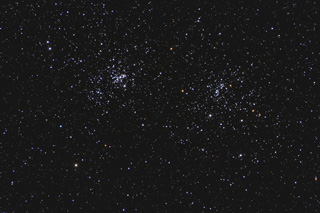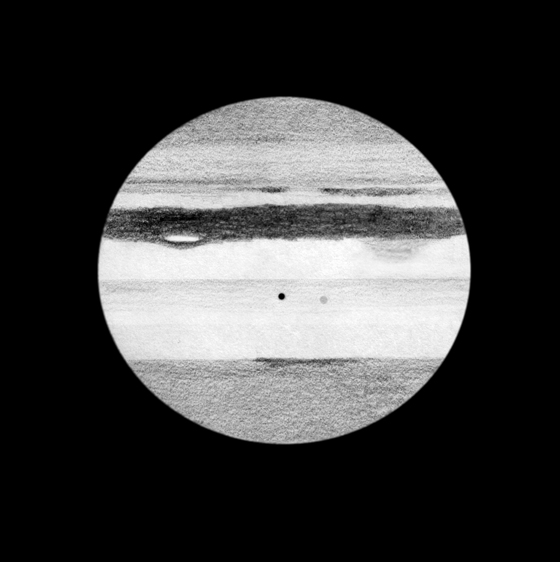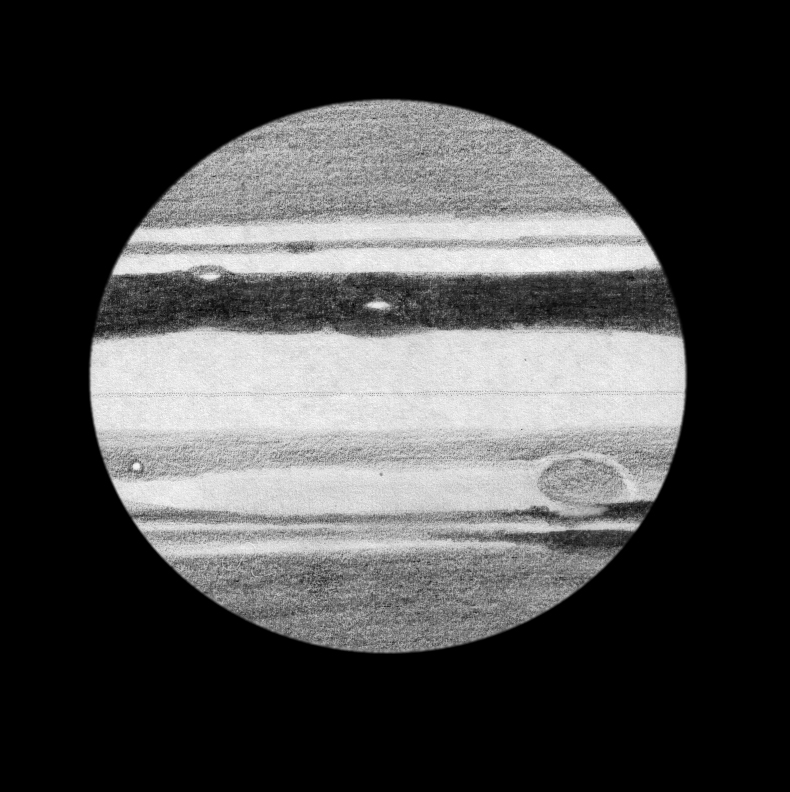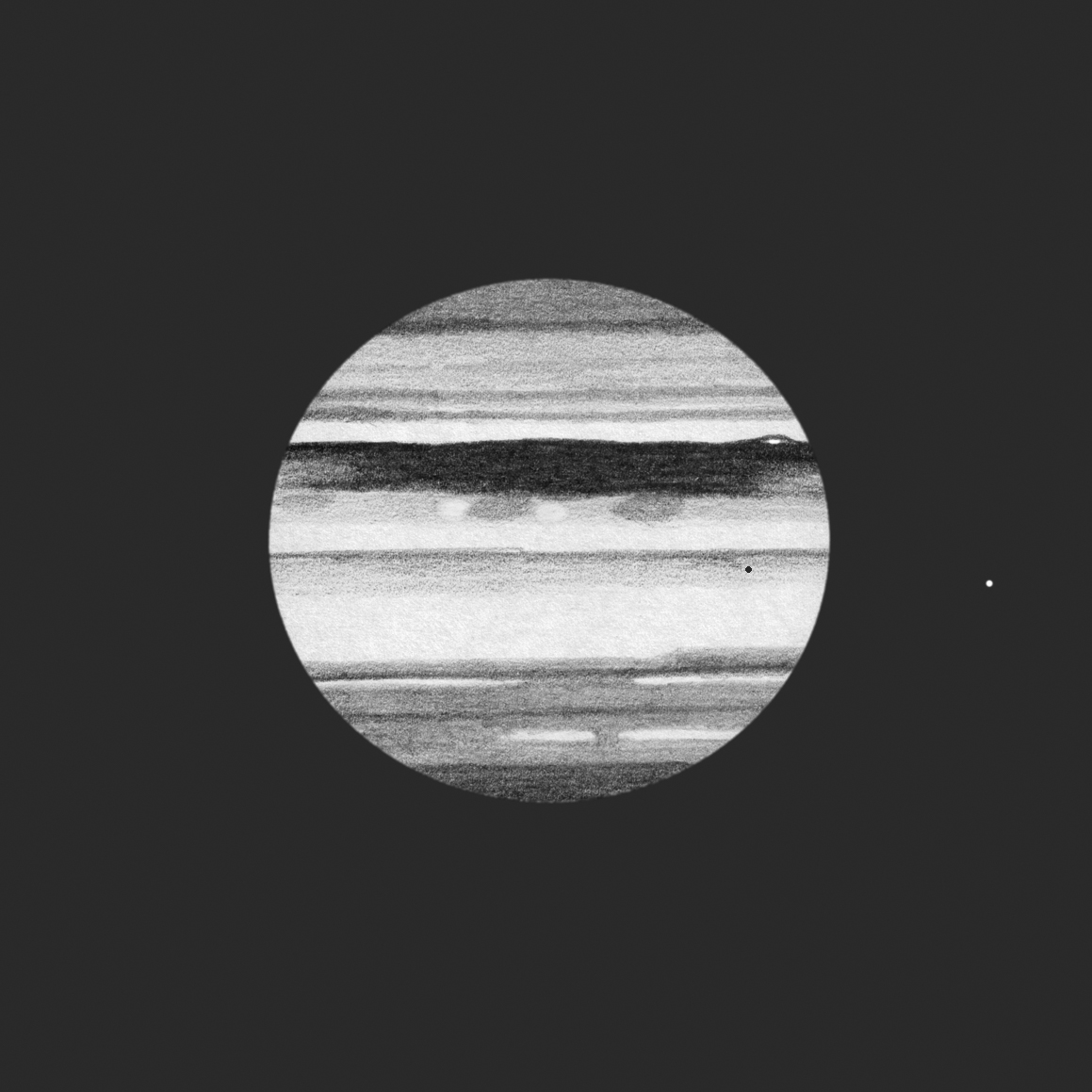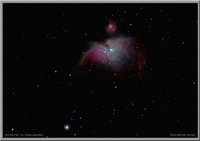- Details
Produktbeschreibung
Erfahrungsberichte unserer Kunden mit Teleskope und Zubehör:
(Hiermit möchte ich Sie ermutigen, uns Ihre Erfahrung mit unseren Produkten, zur Verfügung zu stellen. Vielen Dank dafür!)
AstroProfessional ED102 714mm f/7
ED-APO ED127 und Explore Scientific Flattner
SkyWatcher Evostar 90/900
Ich bin seit sechs Wochen glücklicher Besitzer der Kson-Eklipse-Montierung und muss sagen, dass ich mit dem Gerät mehr als zufrieden bin.
Ich habe in meinem Hobbyastronomenleben schon so ziemlich alle Goto-Montierungen "durchlitten", sei es eine, wo "nur drei helle Sterne" angepeilt werden müssen oder per GPS der Standort ermittelt wird und dann das Teleskop auf z.B Adebar im Storch oder Al-Kaida ausgerichtet werden muss...mehr oder weniger Murks, auch wenn da C. oder M. draufsteht.
Ich weiss nicht WIE, aber aber ich habe festgestellt, DASS die Kwon-Montierung das tut, was man möchte:
Aufbauen oder aus dem Schuppen oder Kofferraum holen, Teleskop anbringen, Batteriepack und Handbox anschliessen, einschalten, EIN helles Himmelsobjekt anpeilen, OK drücken - das war´s. Auch wenn das "helle Himmelsobjekt" der Mond ist - man kann seine Beobachtungsnacht geniessen.
Zwei Sache habe ich zu bemängeln:
a) Die doch recht "rustikale Verarbeitung", die der Funktionstüchtigkeit aber keinen Abbruch tut und
b) die Verbindung Handbox <-> Montierung erfolgt über einen USB-Stecker, der etwas zu leicht einzustecken ist und daher manchmal Wackelkontakte erzeugt, was dann eine Neuausrichtung nötig macht. Ein Stück Klebeband hilft dem ab.
Noch etwas, was für Kleingartenbesitzer und Balkonspechtler wichtig sein könnte:
Das Ding quietscht und jault bei der Ausrichtung nicht und ist im Beobachtungsbetrieb flüsterleise - gut für die Vermeidung von Nachbarschaftskriegen, ich habe da so meine Erfahrungen.
"Im Display der Handbox erscheint beim Einschalten die Warnung, dass es für das Augenlicht nicht förderlich ist, in die Sonne zu schauen...dass tun meines Wissens nach alle Steuerungen, nachdem vermutlich ein Amerikaner diesen Unsinn verzapft hat und einen Hersteller mit Erfolg auf Zigmillionen $ Schadensersatz verklagt hat.
Man nimmt diesen Hinweis mit dem Drücken der OK-Taste zur Kenntnis und beginnt mit der Align-Prozedur z.B um 12:00 Mittags, als "Helles Objekt" bekommt man "Sonne" vorgeschlagen und genau die steuert man an (Herschel-Prisma, Baader-Folie oder Televue-Solar-Finder nicht vergessen!) und nach dem "Align successful" "Venus" eingeben und sie am Taghimmel betrachten.
Versuchen Sie DAS mal mit einer anderen Montierung."
Fazit:
Wenn sich die Existenz und Bedienungsfreundlichkeit dieses Gerätes (abgesehen vom Preis) herumspricht - C. und M. müssen sich etwas einfallen lassen.
Mit freundlichen Grüssen,
Hallo,
Astro Professional ED80/560
Hallo Herr Kloß,
das Teleskop ist heute gut verpackt angekommen, saubere Verarbeitung, super Justage, glasklare Linsen, einfach perfekt, danke für die Mühe! Habe gerade Saturn mit 160 Fach beobachten können, absolut klares und scharfes Bild, mit deutlich sichtbare Cassini-Teilung, der Ring vor dem Planeten mit Schattenwurf, die Planetenkugel schwebt richtig im Ring, Verdunkelungen mit Abstufungen im Kontrast an den beiden Polen sind ebenfalls deutlich zu sehen! Die sphärische Korrektur ist ausgesprochen gut und die Optik hat für einen ED erstaunlich wenig Farbe! Also ich bin rundum zufrieden mit dem Gerät, eine wirklich gute Ergänzung zu meinem 8"F6 Newton von Orion UK! Werde Sie auf jeden Fall weiterempfehlen!!
Viele Grüße Uwe
Hallo Karl,
hier schreibe ich wie versprochen meinen ersten Beobachtungsbericht. Gestern Abend beobachtete ich den Doppelstern Rigel, Merkur, M42, Saturn. Merkur war am besten mit 93x im 6mm Planetary Okular, die Sichel war sehr gut zu sehen trotz der geringen Höhe von 5 Grad ein gutes Bild. Rigel war sehr leicht zu trennen mit , 2 Nadelpunkt feine Sterne, die Optik ist echt super. Dann M42 den ich etliche male schon im 12''er Dobson gesehen habe, trotzdem fazienirt der ,,kleine Refraktor'' durch seine scharfe kontrastreiche Abbildung. Mit 93x war das Trapetz sehr gut aufgelöst und M42 offenbarte reichhaltige Struckturen. Später als Saturn endlich im Süden stand konnte ich es kaum abwarten ihn ausgiebig zu beobachten. Das Bild war bei 140x sehr scharf und kontrastreich , die dunkle Polregion war sichtbar und auch das Hauptwolkenband war sehr gut zu sehen. Meine Erwartungen wurden bei weitem übertroffen. Nun wurde ich neugierig und wollte wissen wie hoch ich vergrössern kann, ohne Details einbüssen zu müssen. Bei 175x war das Bild zwar dunkler aber es waren noch alle Details da, das Bild war noch sehr gut. Nun wurde ich übermütig 224x, ich war erstaunt, das Bild ist noch nicht zusammen gebrochen, aber schon recht dunkel, die schärfe war zwar nicht mehr perfekt aber noch ok, man merkt doch das man doch das man weit über der förderlichen Vergrösserung beobachtet, die details waren aber noch alle vorhanden. Heute dann habe ich die Sonne beobachtet, kurz gesagt ich war begeistert! , es waren zahlreiche Flecken sichtbar, und auch die Granulation auf der Sonne zeigt der Refraktor! Bei 112x hatte ich die beste Abbildung, das Seehing war nicht sehr gut, eher mittelmässig. Und auch bei der Erdbeobachtung ist der Refraktor super, das Bild hell , kontrastreich und scharf. Insgesammt sind meine Erwartungen bei weitem übertroffen, bin erstaunt was ,,nur''80mm Öffnung zeigen können.
Mit freundlichen Grüssen Patrick
SkyWacher SC11
So a bit of review.
The SW C-11 OTA arrived nicely packaged with a big finder, 32 mm Plossl, good diagonal and the visual back. The scope was noticeably bigger and heavier than the C8 I had before. I've installed the OTA on HEQ5 mount and noticed that I need more counterweights. Adding 5kg more (~16kg total) allowed to balance the scope, but I'm planning to use less counterweights on a extender counterweight shaft/bar. On my balcony on vibration suppression pads the mount worked without any problems when imaging Saturn and Venus. No changes compared to the C8 setup. Long time guided exposures haven't been tested yet.
As for the SW C-11 OTA - it has SkyWatcher logo on the side and Celestron logo on the secondary and finder so it's clearly the same design. The factory probably saves time by not rebranding smaller elements for this scopes. The diagonal compared to a standard cheap Antares gives brighter flashlight image and green coatings can be detected. Plossl eyepiece also looks like nicely done, probably by GSO (the same look).
Focus knob on the C11 has more pressure on it than in C8 (heavier mirror to move) and it moves the mirror slower than in the smaller SCT. It probably limits shaking of the mirror but sometimes it's hard to tell if I'm focusing or defocusing. For imaging I also use JMI motocryford attached to the SCT thread - that allows fine focus without moving the mirror. I had only one clear night with this scope and when imaging Saturn and Venus in the morning I didn't noticed any problems with mirror flop. It was steady and there wasn't any unexpected lost of focus. How it will perform on long-term imaging - time will tell ;)
ToDo is to get a dew shield, bahtinov mask and maybe 11" solar filter, checking the extended counterweight bar, guiding (and some new filters :)) The scope will do it's job (I hope). First images obtained at rather poor seeing:
http://www.rkblog.rk.edu.pl/astro/my_astro_images/show/wenus-17122010/
http://www.rkblog.rk.edu.pl/astro/my_astro_images/show/saturn-17122010/
___________________________________________________________
The sky conditions that evening was fair for a city location down to mag 5 (England).
Filter: The filters used for the Horsehead nebula was a composition of R G B for colour information and an Astronomick H Alpha filter for the image luminance .
Exposure: The exposure times was twenty minutes for each colour filter and two hours in H Alpha . The exposures was a composition of two minute exposures stacked with matching dark frames using deep sky stacker software and retuched up on Paint Shop Pro software.
Camera: The camera was an Atik 314L CCD camera
Mount: mount was a Vixen Atlux mount .
Scope: Ekinox (Kson) ED805.5
Dies Aufnahme wurde mit einem noch nicht justierten ED805.5 erstellt.
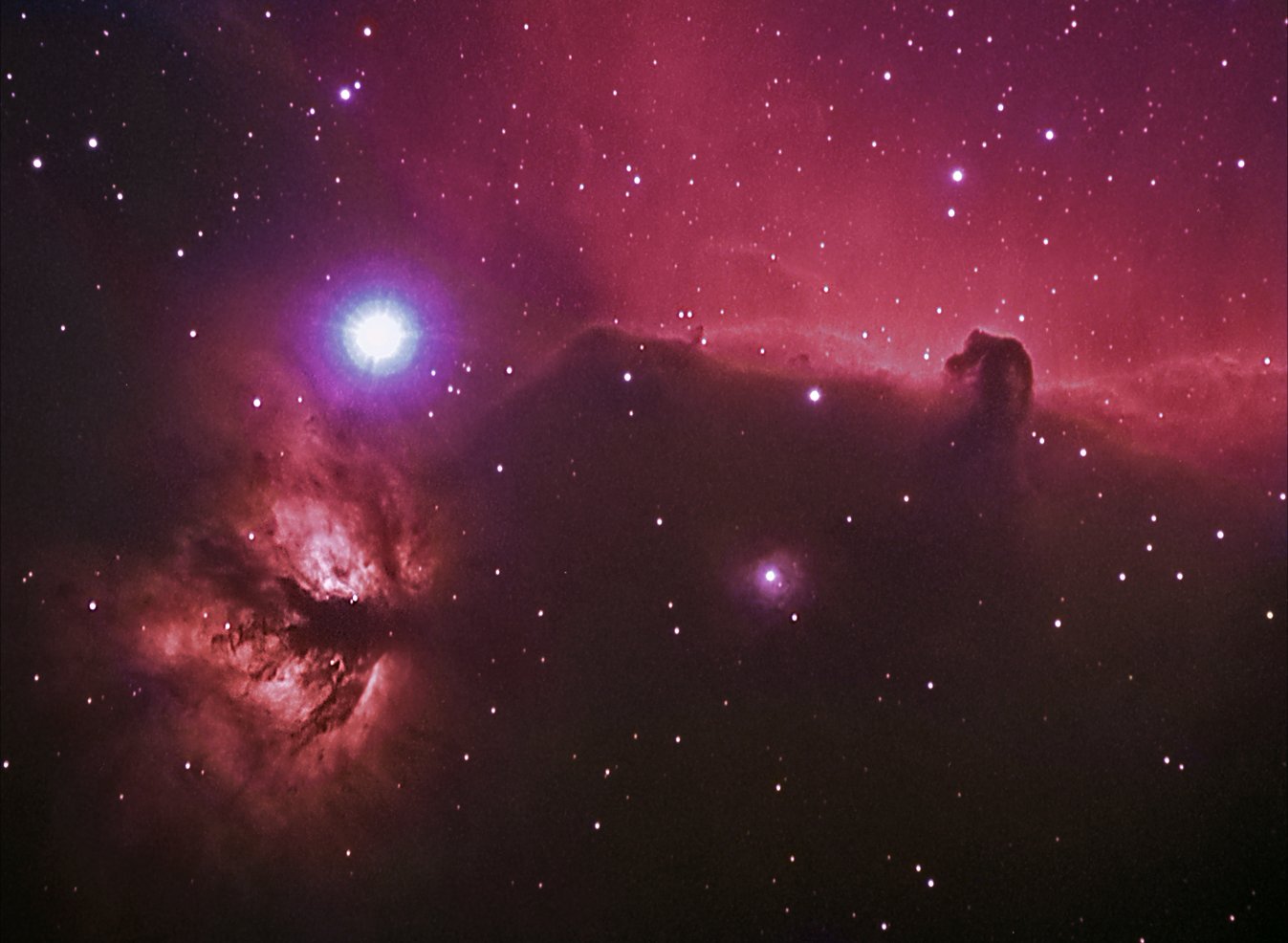
___________________________________________________________
Kson Ekinox ED1026
___________________________________________________________
Kson Dobson 160mm KDB1300160
Teleskop Dobson 160/1300 f:8,1 von Kson KDB1300160
Erfahrungsbericht 1. Eindruck
Aufmerksam wurde ich auf die Firma Teleskop-Spezialisten übers Internet als ich auf der Suche für einen Nachfolger meines Bresser-Refraktors 60/800 war, der meinen Ansprüchen nicht mehr genügte.
Nach Vergleich der technischen Daten in der Preisklasse um 200¤, wurde klar, dass ein Dobson mit besseren optischen Eigenschaften allen anderen mit aufwendigeren azimutalischen oder paralaktischen Montierungen vorzuziehen ist, da qualitativ hochwertige Montierungen bei diesem Preisrahmen nicht erhältlich sind. Wie unterdimensionierte Montierungen, wie bei meinem Bresser einem den Spaß am Teleskop durch verwackeln verderben, weiß ich ein Lied zu singen.
Lichtstarke Refraktoren sind den Reflektoren zwar in den Leistung etwas überlegen, dafür aber viel teurer.
Die unzähligen „114er Kaufhaus-Reflektoren“ chinesischer Fertigung, sind meinem „alten 60/800“ , dem ich mit 1,25“ Amici-Prima und großen Okularen etwas mehr Leistung gegönnt habe, auch nicht überlegen.
Ein 150er Newton hat etwa das doppelte Leistungsvermögen eines 114er, sofern bei beiden die Qualität stimmt und die steht und fällt mit dem Händler und seiner „Nacharbeit“. Da heutzutage alle Hersteller entweder nur die Teile „konfektionieren“ oder gleich in Guandong fertigen lassen, muss man schon genau schauen, was man bekommt. Ein toller Markenname sagt nicht aus.
Nun zum Kson 160/1300:
Da ich in München zuhause bin und hier so eine Ansammlung an Teleskopfirmen ist, wollte ich mir das Gerät nicht schicken lassen, sondern anschauen und mir selbst einen Eindruck von der Qualität machen.
Herr Karl Kloss von der Firma Teleskop-Spezialisten erwies sich als typischer „Techniker“ der alten Schule, dem es hauptsächlich darauf ankommt, seinen Kunden zufrieden zu stellen, indem er ein ordentlich überprüftes, optimiertes und bestmöglich justiertes Gerät übergibt.
Der Spiegel wurde entspannt.
Herr Kloss musste so ziemlich alles nachziehen – Die Qualitätskontrolle gehört nicht zu den Stärken der Chinesen. Aber solange die Qualität der Technik stimmt, ist das für mich kein Problem. Das ganze dauerte etwa 1 Stunde und war zugleich eine kompetente Einführung in die Benutzung.
Teile:
- Die „Rockerbox“ Dobson Montierung besteht aus 2 Zentimeter starkem, weis lackiertem Melaminharz/Holz feiner Struktur (nicht wie Pressspan) und macht einen ziemlich stabilen Eindruck, was sich in der Praxis in geringen Nachschwingungen bezahlt machen dürfte. Die Lager für die Drehung haben wenig Spiel sind aber trotzdem genug gängig. Ein nützlicher Handgriff und eine kleine Ablage für Okulare sind vorhanden, Die Teleskopauflage sitzt gut, aber der Lack schleift dort ab. Die Lackierung ist insgesamt nicht auf höchstem Niveau. Gewicht 12Kg.
- Das Newton hat einen parabolischen Spiegel aus Floatglas und ist mit 160er Öffnung etwa 6,75% dem 150er überlegen – nicht die Welt, aber trotzdem. Der 2“ Okularauszug ist solides Metall, aber ein bisschen grobschlächtig, dafür auch für große Okulare geeignet. Auch die Aufhängung schaut stabil aus. Mit 1,3 Meter Länge und 21 Zentimeter Durchmesser ist das schon ein ziemliches Trumm. Gewicht ca.6Kg.
- Mit Adapterring passen die 2 mitgelieferten 1,25er Super Plössl und die 3xBarlow. Bei 1300 Brennweite ergibt das eine Vergrößerung von 52x und 130x.
- Der Leuchtpunktsucher nach Teleradart wurde ausgerichtet.
- Passende Deckel sind dabei.
Zu empfehlen wäre noch ein 6er für 217x optimal sinnvolle und ein 32er Okular für 40x Deepsky Vergrößerung, sowie ein Mondfilter.
Astrofotografie ist mit dem Dobson so zwar nicht möglich – abgesehen vom Mond- aber eine Nachrüstung mit einer NEQ3 Montierung und Motornachführung ist durchaus machbar und dann geht auch fotografieren.
Fazit:
Das Kson 160/1300 Dobson ist für mich als fortgeschrittener Anfänger ein super Teleskop zu einem tollen Preisleistungverhältnis.
Allerdings ist dafür auch die engagierte Nacharbeit von dem Teleskop-Spezialisten Karl Kloss verantwortlich.
Jetzt muss sich das ganze in der Praxis bestätigen. Ich werde berichten.
Grüße Friedrich Koob
------------------
Hallo Herr Kloss
Ergänzung zum letzten Bericht
Praxis:
Es dauerte eine Zeit, bis das Wetter für einen Test im Freien gut genug war. So konnte ich das Gerät erst im Trockenen ausprobieren und etwas optimieren.
-Die mitgelieferten 1,25 Super Plössl Okulare (10, 25, 32) und die 1,8 fach (nicht 3x, wie ich zuerst dachte) Barlowlinse sind besser, als was sonst so an Anfängerbeigaben mitgeliefert wird. Das hat sich auch terrestrisch an meinem "alten" Refraktor im Vergleich zu den Meade Okularen (4, 6, 12) bestätigt.
-Meine erste Skepsis gegenüber der Barlow (Lichtverlust und chromatische Fehler) haben sich nicht bestätigt, so dass ich für den Anfang gut ausgestattet bin.
An beiden Teleskopen ergeben sie ein deutlich größeres, helles und bis in die Randzonen scharfes Sichtfeld.
-Der Leuchtpunktsucher ist etwas schwierig zu justieren, da das Plastikfutter der Einstellschräubchen nicht hält. Ich hab es mit etwas Plastik aufgefüttert- jetzt geht's-, aber bei Dämmerung sehe ich die Ringe nicht, so hab ich noch zusätzlich einen konventionellen 6x30 Sucher (Bei E-Bay für 12¤ fast neu) montiert. Mit der Kombination bin ich jetzt sehr zufrieden.
-An der sehr stabilen Rockerbox habe ich die eine Feststellschraube gegen einen Handgriff von eine alten Flex ausgetauscht, das hilft beim feststellen in der Altitude, wie beim nachführen azimutal. Wenn man am Rohr selbst dreht vibriert es etwas.
Die Schraubenlöcher hab ich mit weisen Plastikstöpseln vom Baumarkt (1,80¤) verschlossen und beim Drehbolzen die Zwischenräume mit Kunststoffringen aus alten CD-Spindeln spielfrei aufgefüttert.
Noch stört, dass die Rollen direkt auf dem Lack der unteren Holzscheibe laufen und sich regelrecht eingraben. Hier werde ich noch eine dünne Metallscheibe (alter Deckel von einem Blecheimer) reinkleben, dann läufts sauberer und wenn es geht mach ich am Rand noch eine Gradskala auf den Deckel und eine kleine Libelle zum ausrichten und ins Lot bringen.
Wenn ich dann nach Norden ausrichte, kann ich so schon grob einstellen.
-Einen Satz mit 4 Meade Filtern gabs bei Amazon recht günstig.
-Am Computer benutze ich das kostenlose Stellarium und das Kosmos Himmelsjahr 2011. Im Internet findet man jede Menge Software und auch Literatur.
- An Büchern den Rückl, Bildatlas des Weltraums, Rückl, Sternbilder, Corvus, großer Atlas der Sterne, eine drehbare Sternkarte und Roth, Handbuch für Sternfreunde.
Beobachtung:
In den letzten Tagen waren Jupiter und Uranus gut im Süden von meinem Wintergarten aus zu sehen. Ich weis, ich sollte einen besseren Standort wählen, aber fürs erste reicht es. Der Jupiter zeigte mehrer Bänder, die Jupitermonde waren knackscharfe Punkte bis zu 130x mit dem 10er Okular, beim Uranus bin ich mir noch nicht sicher, ob er es auch war. Bei der 200x Vergrößerung lief mir die Sache zu schnell aus dem Blickfeld, da muss ich noch viel üben und auch einen besseren Standort haben.
Für mich sind die Vergrößerungen 40x bis 100x wichtiger, als die maximale 320x mit dem 4er, für die ich sowieso einen Standort irgendwo auf einem Berg brauche.
Der Mond war zu voll um wirklich ernsthaft zu beobachten, aber der Fortschritt zum Refraktor ist deutlich.
Für den Orionnebel gilt ähnliches.
Reflexe sind mir nicht aufgefallen und ob ich da mit schwarzer Samtfolie noch was verbessern kann, ist fraglich.
Auf jeden Fall ist das Gerät sehr gut justiert und entspricht meinen Erwartungen.
viele Grüße Friedrich Koob
___________________________________________________________
Kson Dobson 102mm
Sehr geehrter Herr Karl Kloß,
vielen Dank für die schnelle Lieferung des Dobson von KSON 102/640, es ist alles gut
angekommen.
Kurze Einschätzung: Alles einzeln, sicher verpackt und eine englische Aufbauanleitung die
man wirklich nicht braucht. Wenn dennoch Bedarf besteht, ist die aussagekräftige
Bebilderung in der Anleitung sehr gut.
Der Tubus ist sauber verarbeitet, durch das gefalzte Rohr ist es am unteren Ende nicht ganz
rund, unerheblich für die Nutzung. Die Spiegelzelle ist großzügig gestaltet, keine Abschattung
durch den Okularauszug. Auch der Fangspiegel ist in der Verarbeitung topp, die
Justierschrauben an ihm und am Hauptspiegel sind wirklich praxisgerecht, keine fummeligen
Madenschrauben.
Die Montierung ist gut verarbeitet, die Schraubverbindungen haben alle gepasst. Bei der
Okularhalterung waren die Schrauben etwas lang, durch zwei Unterlegscheiben aber einfach
zu ändern. Durch die schöne gleichmäßige und auch dicke Lackierung der Montierung passen
die Okulare mir auch etwas zu stramm, auch eine Sache, die man, wenn man es möchte
einfach ändern kann und den guten Gesamteindruck in keiner Weise schmälert. Die
Azimutausrichtung ist durch die Rollenlagerung gleichmäßig und leichtgängig, vielleicht bei
sehr hohen Vergrößerungen etwas zuviel, aber dafür ist meiner Ansicht der Newton auch
nicht gedacht. Bei der Höhenausrichtung habe ich die Unterlegscheibe beidseitig und den
Feststellknopf mit Samtfolie beklebt um die Reibung etwas gleichmäßiger zu verteilen. Die
Funktionsweise ist aber auch ohne die Maßnahme ohne Einschränkung.
Der Red Dot Finder wird seinen Namen gerecht, ist schnell angebracht und auch schnell
justiert, besser als jedes 5x25 Sucherröhrchens und allein für ihn müsste man auf dem
Astromarkt bestimmt um die 20,-¤ hinlegen.
Gestern First Light des Dobson, feine saubere punktförmige Sternabbildungen nach 30min.
Auskühlzeit, die Beobachtung von Orionnebel und Plejaden waren mit einem 32er Plössel
einfach Klasse.
Mit dem 12,5 und auch in Verbindung mit einer 2fach Barlowlinse und den damit
erreichbaren Vergrößerungen, intrafok. / extrafok.,- gleichmäßige Beugungsbilder am Stern.
Die mitgelieferten Okulare sind von guter Qualität, auf dem Astromarkt und mit den
entsprechenden Namen drauf, würden sie dann ja, schon die Hälfte des Preises des Fernrohrs
kosten. Die 3fache Barlow habe ich noch nicht ausprobiert. Also kurz gesagt prima Teil,
leicht und schnell aufgebaut, Es wird bei den wenigen Tagen mit guten
Beobachtungsbedingungen bei mir vor Ort immer dabei sein.
Für Einsteiger finde ich es auch einfach ideal, bei entsprechender sicherer Aufstellung(auf
Hocker, Tonne oder ähnliches)
Mit astronomischen Gruß
Matthias
___________________________________________________________
Kson Dobson 80mm
Der Zusammenbau der Montierung dauerte Dank der sehr guten Passungen nur wenige Minuten. Das nötige Werkzeug ist im Lieferumfang enthalten!
Die Montierung besteht aus weiß lackiertem, sehr stabilen Sperrholz. Die Platte zur Aufnahme des Tubus ist zusätzlich noch mit einer Finne verstärkt, in der ein Handgriff eingearbeitet ist. Die Rollenlager im Azimut lassen sich, durch eine handliche Rändlmutter, gut einstellen.
Der Dobson war schon ordentlich vor justiert; es bedurfte nur ein paar kleinen Korrekturen am Stern, dass sich ein gutes Beugungsbild zeigte!
Der Leuchtpunktsucher ist gut und verfügt über zwei schaltbare Helligkeitsstufen.
Die beiden mitgelieferten Okulare, ein 25er und ein 10er Plössl, sind mehrfach vergütet und von guter Qualität! Also nicht diese Schrott-okus, die sonst in dieser Preislage dabei sind!
Mit dabei ist eine 3-fach Barlowlinse aus Kunststoff, jedoch mit einem achromatischen Element.
Die Abbildungseigenschaft der Barlow ist gut, bzgl. der 500mm Brennweite (f6,3), hätte hier eine 2-fache genügt.
Mit einen 4mm Okular (aus meinem Fundus) war das Bild, bei 125-facher Vergrößerung, erstaunlich scharf und kontrastreich.
Vorbehaltlich Spaß macht es, mit dem 25er Okular, die Milchstaße, bei 20-facher Vergrößerung, zu durchstöbern, hier ist das Bild bis zur Rand scharf! Aber auch am Planeten macht er eine ganz gute Figur!
Alles in Allem ein gelungener Mini-Dobson, mit toller Ausstattung, für das schnelle Spechteln zwischendurch, bzw. wenn ich zu faul bin meinen 10 Zöller aus dem Keller zu holen, um anschließend noch eine Stunde warten zu müssen bis er sich klimatisiert hat.
Liebe Grüße
Frank
Hallo Herr Kloss!
Nach dem nun etwas Zeit ins Land gegangen ist, gab es nun letztens Gelegenheit den KSON zu testen. Ich muss vorausschicken, dies ist mein erstes Spiegelteleskop. Was man aber wohl auch ohne Spiegelerfahrung beurteilen kann, ist erstmal die Verpackung. Und die war schon mal gut. Dann der Zusammenbau: kein Problem. Mir fiel nur auf, das die Bilder in der Bedienungsanleitung mehr oder weniger schwarz auf schwarzem Grund waren, kurzum: kaum leserlich. Andererseits habe ich keine Bedienungsanleitung zum Zusammenbau benötigt (hoffe ich doch!). Negativ fiel auf, dass die Schrauben für die Rollenlager bereits kräftig Flugrost angesetzt hatten.
Fertig zusammengebaut (bestimmt keine halbe Stunde) hat man ein gefälliges Gerät vor sich stehen, dass sich gut bedienen und einstellen läßt. Ein erster Blick am Tag durchs Okular auf ein paar nahe gelegene Bäume versetzten mich dann erst mal in Erstaunen: das Ding ist ja richtig gut! Das Bild war jedenfalls für meine Begriffe klar und kontrastreich und vor allem erstaunlich randscharf. Und in jedem Fall besser, als wie ich es erwartet hatte.
Ein paar Tage später gab es dann auch Gelegenheit den KSON am Sternenhimmel zu testen. Als erstes überzeugte wieder die Randschärfe beim allgemeinen "Sternsurfen". Das Gerät ließ sich dabei gut einstellen und führen. Ein Blick auf den Andromedanebel als konkretes Objekt fiel dann auch zur vollen Zufriedenheit aus, was bei meinen Sichtbedingungen (Stadt, Erdgeschoss und jede Menge Straßenbeleuchtung) heißt: der Nebelfleck war sofort auszumachen. Bei einem im selben Preissegment angesiedelten 8*30 Bino muss man da schon zweimal indirekt schauen. Insgesamt war die "Bildästhetik" wirklich gut und ich positiv überrascht, was mit der kleinen Öffnung in Sachen Schärfe und Kontrast mir geboten wurde.
Ich würde das Gerät also als Astroappetizer empfehlen. Man sieht mit ihm mehr, als man denkt und weniger als man dann möchte. Ich finde, es ist sein Geld wert und optisch und mechanisch absolut brauchbar für erste Schritte.
Allzeit klare Sicht und nochmals vielen Dank fürs Gerät
Sehr geehrter Herr Kloß,
Positiv: Der Leuchtpunktsucher war im Nu ausgerichtet und weißt jetzt zuverlässig den Weg.
Negativ: Sobald ein Okular im Halter war hielt die Einstellung in Höhe nicht. Hier muss man das entsprechende Klemmrad wirklich "anknallen"; jetzt funktioniert die Höheneinstellung auch bei schweren Okularen. Die Verstellung läuft jetzt etwas ruckeliger als bei meinem Dobson, nach kurzer Zeit bekommt man aber ein Gefühl für die nötige Kraft zum Nachschubsen.
Positiv: Der Fokus liegt so, dass das Auszugsrohr bei scharfem Bild nicht in den Tubus ragt; die ist leider nicht bei allen Röhren so.
Die beiden mitgegebenen Okulare sind recht ordentlich und geben am Mond ein Bild, das auch schon wieder ein paar Nachbarn begeistert hat. Die mitgegebene Barlow ist schon recht mäßig, mit einer kurzen 2 x Barlow von Seben war das Bild bei gleicher Vergrößerung deutlich besser vor allem am Rand des Gesichtsfeldes.
Ich habe außer den mitgelieferten verschiedene andere Okulare ausprobiert. Mit einem 32- er Plössl ist das Rohr etwas überfordert, es fällt schwer den Fangspiegel zu ignorieren. Ein 25 mm Weitwinkel verträgt es klaglos und gibt ein schönes Bild bei recht erquicklichem Gesichtsfeld. Die Vergrößerung ließ sich bis über 100 x hochtreiben, dabei gelang das Fokusieren und der Okularwechsel ohne das das Objekt sich verabschiedete. Hier ist das Kson irgendwelchen Tschiboskopen u.ä. deutlich überlegen und damit für Anfänger deutlich besser geeignet. Die Aufbewahrungslöcher für die Okulare sind für die aktuellen Okulare etwas klein, ich werde sie noch rechtzeitig mit Schleifpapier gängiger machen.
Fazit: Das Kson ist ein Gerät, das man Anfängern ohne weiteres empfehlen kann. Das werden wir natürlich auch auf dem Astronomietag tun. Der Gelegenheitsgucker hat damit eigentlich genug und bei den anderen erwächst im Laufe der Zeit der Hang zu einem größeren Dobson.
Vorerst bedanke ich mich für alles und verbleibe mit bestem Astrogruß
Gerhard Schmitt
___________________________________________________________
___________________________________________________________
150mm f/12 (1800mm) Maksutov-Cassegrain
Hier ein paar sehr schöne Jupiterzeichnungen die mit unserem 6"er MAK erstellt wurden:
Vielen Dank an Lambert Spix! http://www.sky-scout.de/
Auf das jeweilige Bild klicken für eine grössere Ansicht!
___________________________________________________________
100mm f/10 (1000mm) Maksutov-Cassegrain Gamma MC 4" f/10
Hallo Herr Kloß,
heute möchte ich meinen Erfahrungsbericht zum 102mm Rumak von Bosma an Sie weiterleiten. Das Gerät wurde von Ihnen perfekt justiert und auch der Zenitspiegel hat nochmals nach Ihrem Eingriff an Justage gewonnen. Mit einer Länge von 33cm ist dieses Gerät wirklich handlich, auch wenn es recht solide wirkt, wenn man es in der Hand hält. Die Prismenschiene mit den Fotostativanschlüssen kann ich für meine azimutale und meine parallaktische Montierung nutzen. Beides sollte recht stabil ausfallen, denn mit diesem Maksutov bewegt man sich gerne jenseits der 100fachen Vergrößerung. Als f/10 – Gerät kann es aber auch etwas größere Austrittpupillen erreichen und ist für den Einsatz im DeepSky-Bereich ebenfalls geeignet.
Ich habe dem Gerät noch eine flexible Taukappe gegönnt, welche ich zum Unterdrücken von Reflektionen mit Velour ausgelegt habe.
Doch zum Einsatz: Das Gerät wird von mir im Winter eine Dreiviertelstunde vor Beobachtungsbeginn abgekühlt. Das rentiert sich, denn Schärfe und Kontrast steigern sich enorm, wenn das Gerät vernünftig temperiert ist. Diese Tage ist der Mars in der Opposition und wenn auch dieses Mal nicht besonders groß, so habe ich diesen als erstes ins Visier genommen. Mit 125facher Vergrößerung war die nördliche Polkappe gut zu erkennen, sowie die Dunkelgebiete. Die Schärfe und die feinen Kontrastunterschiede auf der Marsoberfläche waren beeindruckend. Schade, dass ich kein Okular für eine höhere Vergrößerung besitze. Am Mond war auch der Kontrast sehr auffallend – so vielfach schattiert hatte ich die Oberflächen des Mondes noch nicht gesehen – es waren nicht nur die Krater, welche hier faszinierten.
Da mein größeres Interesse der Deepsky-Beobachtung gilt, habe ich selbstverständlich auch hier ein paar Objekte ins Visier genommen. Ich verwende übrigens gerne einen Leuchtpunktsucher. Das Trapez im Orion war mit 100facher oder 125facher Vergrößerung gut zu erkennen, was aber fast noch mehr faszinierte, war die Nebelstruktur rund um das Trapez bei 125facher Vergrößerung. Hier waren die Strukturen des Nebels als Fasern zu erkennen, die Dunkelgebiete fein abgegrenzt. Ein schön kontrastreiches Bild.
Neben dem bekannten Eskimonebel (planetarischer Nebel) habe ich zum Schluss noch das Duo M38/NGC1907 im Fuhrmann ins Gesichtsfeld geholt. Dieser Anblick war fantastisch. Mit einem 19mm Okular (53fache Vergrößerung, 1.2° reales Gesichtsfeld) konnten der große M38 mit seinen Sternenreihen und daneben der kleine, wolkenartige NGC1907 gleichzeitg gesehen werden. Diese beiden Objekte sehen sehr unterschiedlich aus und vor dem rabenschwarzen Himmel kam bei mir gar kein Bedürfnis auf, hier höher zu vergrößern. Bei indirektem Sehen waren selbst mit dieser Vergrößerung schon Einzelsterne im NGC1907 zu erkennen.
In Summe ist es ein sehr transportables Gerät mit bemerkenswertem Kontrast und einer sehr hohen Schärfe. Hier macht sich auch die sorgfältige Justierung in der Teleskop-Werkstatt und eine gute Optik bezahlt. Das Gerät sollte gut an die Umgebungstemperatur angepasst sein (wie jedes geschlossene Spiegelsystem), dann ergibt sich nochmals ein merklicher Leistungsschub in der Bildschärfe. Durch die Brennweite von 1000mm bei 102mm Öffnung lassen sich noch gute Gesichtsfelder und Austrittspupillen erreichen, so dass ich das Gerät auch für meine Deep-Sky Beobachtungen gut nutzen kann.
Viele Grüße und clear skies,
Stefan Deichsel
___________________________________________________________
UWA 82° Okular
Ein Bericht über das UWA 6,7mm und 11mm 82°
Hallo Charly;
habe gestern mal wieder mit den Okularen von Dir beobachtet (UWA 82°, 6,7mm und 11mm). Bin jetzt zwar nicht der
___________________________________________________________
UWA 30mm 82° Okular
Ein Bericht über das UWA 30 mm 82°
Dem Bericht möchte ich vorausschicken, dass ich zwar schon über 10 Jahre Astronomie als Hobby betreibe, ich aber im Testen von Okularen kein Spezialist bin und hier lediglich meine subjektive Meinung äußern kann.
Als letzte Woche das von mir bestellte UWA 82° Okular ankam, packte ich es natürlich gleich aus und als es dann vor mir lag, war mir doch etwas bange. Das Okular war noch größer, als ich es mir vorgestellt habe. Die Küchenwaage zeigte etwas über 1300 Gramm an. Optisch machte es auf mich einen edlen Eindruck, alles sauber verarbeitet. Die Okularhülse besaß eine Sicherungsnut, die Linsen schimmerten in einer grünen Vergütung. Dem Okular fehlen die Gummikappen zur Streulichtunterdrückung. Das Problem wird hier auf andere Art und Weise gelöst. Die Feldlinse des Okulars wird durch verdrehen des Okularkörpers in dem Okular praktisch versenkt, und zwar stufenlos, so dass jeder die gewünschte Tiefe selbst bestimmen kann. Ich fand das ganz praktisch, denn jeder kennt das Problem verloren gegangener Gummimuscheln.
Nach dem äußerlichen Begutachten wollte ich es einem ersten Test unterziehen. Ich setzte es in meinen 250/4,8 Newton ein und richtete bei Tageslicht die Optik auf den Berliner Fernsehturm. An der rot-weißen Sendeantenne kann man schön vergleichen, wie groß das Sehfeld des Okulars ist. Als Vergleich habe ich mein 30 mm Eudiaskopisches von Baader benutzt, was natürlich kein Gegner bei der Feldgröße sein kann, sondern höchstens in den Punkten Schärfe und Transparenz. Denn da ist es anerkannt gut bis sehr gut. Ein Blick durch die beiden Okus zeigte mir erstmals wie klein das Sehfeld des Baaders doch im Vergleich zu dem UWA ist.
Das Einblickverhalten des UWA Okulars empfand ich als angenehm, schöner Augenabstand. Lediglich die Größe fiel hier nachteilig auf. Wenn man sich dem Okular nähert, stößt die Nase an das Okular an. Man muss dadurch den Kopf etwas von der optischen Achse des Okulars verdrehen und diese Verdrehung des Kopfes mit dem Auge kompensieren. Man schaut dabei also nicht ganz gerade aus. Hat man sich erstmal daran gewöhnt, sollte das aber kein Problem sein. Als angenehm empfand ich noch, dass man beim Beobachten den Kopf leicht auf das Okular legen konnte und dadurch eine sehr entspannte Haltung eintrat. Durch die abgesenkte Linse bestand auch nicht die Gefahr, dass die Augenwimpern Fettspuren auf das Okular auftragen.
Die Fokuslage des UWAs lag noch etwas hinter der des Baaders. Der Teleskopauszug sollte also nach hinten noch etwas Platz haben. Oder man benutzt so wie ich eine Verlängerungs-hülse.
Am selben Abend hatte ich auch noch Zeit, die beiden Okulare auf meiner Balkonsternwarte zu vergleichen., M27 war im Baader schnell gefunden , unter Randberliner Himmel nicht berauschend, aber doch deutlich zu sehen. Der Blick durch das UWA zeigte fast den gleichen Anblick. M27 war genauso gut zu sehen, nur eben in einem viel größeren Feld. Als nächstes Objekt stellte ich den Ringnebel in der Leier ein. Er ist zwar sehr klein, dafür aber flächenheller und dadurch auch im Berliner Randgebiet leicht zu finden. Das Baader zeigte ihn als winzigen kleinen Rauchring. Auch hier bestand der Unterschied zum Baader nur darin, dass M57 im UWA in einem wesentlich größeren Feld stand. Das Sehfeld reichte dabei über die zwei „Fußsterne“ der Leier hinaus und ergab dadurch einen schönen Anblick. Der Abstand der beiden Sterne am Himmel beträgt etwas über 2°, so dass ich jetzt auch ungefähr wusste, wie viel Grad mir das Okular am Himmel zeigt. Außerdem konnte ich jetzt gleich noch sehen, wie scharf die Sterne im gesamten Sehfeld abgebildet werden. Ich bemerkte nur im äußersten Bereich des Sehfeldes eine leichte Koma, ähnlich der Koma des Baader, die sich aber in der Beobachtung für mich nicht mehr als störend bemerkbar machte. Die Bildästhetik war, meiner Meinung nach, nicht mehr durch kometenhafte Sternabbildungen beeinträchtigt.
Zum Schluss schwenkte ich noch zum zu ¾ beleuchteten Mond. Im Vergleich der beiden Okulare konnte hier das Baader im Bezug auf Schärfe etwas punkten. Das UWA wirkte am Mond nicht direkt unscharf, aber das Baader bildete etwas knackiger ab. Am Ende des Abends zogen langsam aber sicher ein paar Wolken auf. Da kam noch mal der große Augenblick des UWAs. Der Mond stand in dem großen Gesichtsfeld und wie ein Theatervorhang zogen die Wolken vor ihm daher. Einfach schön. Das verstärkte dann noch einmal den ohnehin schon positiven Eindruck. Zum HTT im September wird es auf alle Fälle dabei sein. Vielleicht kann ich es dort auch mal direkt gegen das 31er Nagler unter richtig dunklem Himmel testen. Einen 2 Zoll UHC Filter werde ich dann auch noch haben, so dass dann auch schwierigere Nebelgebiete in die Reichweite meines 10 Zoll Newton kommen werden.
Michael Barchmann
"NoName" ED127
___________________________________________________________
Diese Woche konnte ich zweimal mit dem apo beobachten, und ich bin sehr zufrieden. M15 gut aufgelost bei uber 300x, nadelfeine Punkte, sehr schon. Und gesternabend der Orionnebel , mit OIII filter und 10 mm speers Waler, eben in der Stadt wuinderschon, mit vielen details. Auch die nebel rund den Plejadensterne waren sichtbar, und selbst M1, was mit meiner ehere C9,25 ganz schwierig war in dieser lichtverschmutzten Umgebung.
Mit freundlichen Grussen,
Niederlande
___________________________________________________________
Direkter Vergleich zwischen unserem ED127 und einem TEC 140 bei gleichen Bedingungen:
Clavius ED127 Clavius TEC140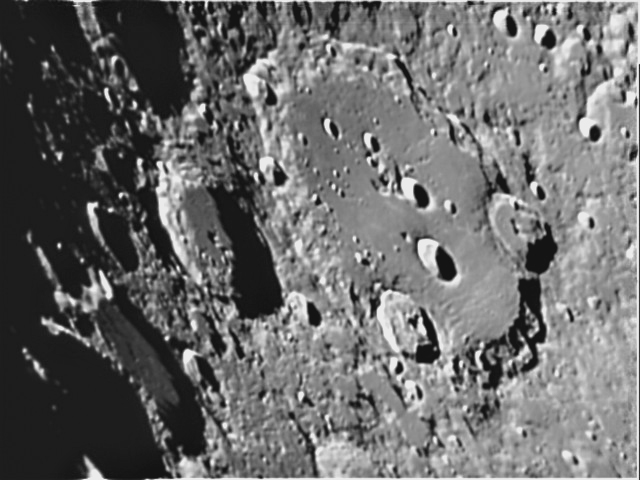
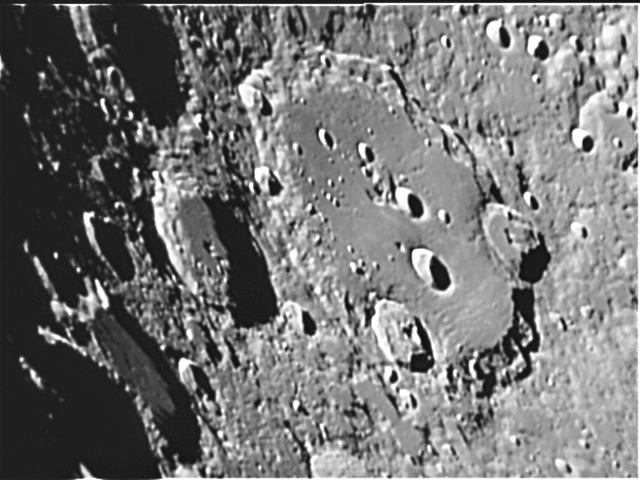
Hallo Herr Kloss,
Ein Freund von mir hat einen TEC 140, und gesternabend haben wir dann den TEC und den 127ed apo nebeneinander gesetzt, und einen Vergleich gemacht. Wir waren in den Stad, also die Orionnebel war in beiden mit OIII gleich, auch den Doppelstern Rigel, obwohl der begleiter ein bischen heller war in den Tec (etwa mehr Offnung).
Auf der Mond waren die Bilder bei den 127ed nahezu gleich an den TEC140. Die 4 Craterlets in Plato waren alle gut sichtbar mit einen 3,5 mm Nagler. Auch die Rillen rundum Ramsden waren sehr schon. Ich habe mit den Kamera (Canon powershot) hinter einen Nagler 7 mm bei 4x zoom in den kamera Avi’s von Clavius gemacht, und beide gleich bearbeitet in registax und Photoshop. Ich sende ihnen die Aufnahmen zur Vergleich, auf beiden kann man alle Kraterchen in Clavius die in den Rukl Atlas stehen, sehen. Sie durfen sagen ob Sie einen untserschied sehen.
Mein Freund war sehr beeindruckt, speziell als der den Preisunterschied erachtete!
Ich darf wohl sagen dass es bei den 127ed triplet “Value for money” gibt!
Mit freundlichen Gruessen
___________________________________________________________
"NoName" ED102
___________________________________________________________
Hallo Herr Kloß,
konnte Gestern ein tolles First Light meines ED 102 genießen.Der erste Blick auf den tiefstehenden Jupiter zeigte schon mehr Details in den Wolkenbändern als beim 90 mm Refraktor, allerdings ist die Auskühlzeit auch etwas länger,hatte ich vorher nicht bedacht.
Da die Monde alle neben dem Jupiter standen, ging ich weiter zu den Doppelsternen. Zuerst zu Gamma Del (4m3/5m1 9,2 ") und Struwe 2725 (7m5/8m0 6,1") die schön zusammen in ein Gesichtsfeld des TS 15mm SW Okular passen und bei 47 facher Vergrößerung gut getrennt zu sehen waren. Durch die unterschiedliche Helligkeit der Doppelsterne ein interssanter Anblick. Danach weiter zu Epislon Leier alle vier Komponeten gut zu sehen im Hyperion 5mm Okular , M57 war als schöner Rauchkringel zu sehen. An der Wega habe ich die Beugungsringe geprüft und es sieht sehr gut aus , keine Anzeichen von Verspannung, Koma oder der gleichen, das justieren der Optik hat sich gelohnt.
Habe danach mich in Richtung Rho Her (4m5/5m5 4,2") begeben der schon mit Zoomokular bei10mm getrennt wurde, bin auch kurz bei M13 vorbei der am Rand aufgelöst Einzelsterne zeigte aber der aufsteigende Mond machte sich bemerkbar. Auch M26 oder M27 wirkten so mehr so toll. Also auf zum Mond. Den ich danach ins Auge fasste und den Krater Jansen beobachtete auch die Rimae Jansen war sehr gut zu sehen, im Hyperion 5mm Okular bei 142 fach ein sehr schöner Anblick mit vielen Details im Krater , auch die noch halb im Schatten liegenden Krater Fabricius und Mitrius waren sehr schön zu beobachten. Auch mit dem Hyperion 3,5mm 204 fach war das Bild sehr kontrastreich und klar. Keine Farben für mich sichtbar.
Habe dann nach ca. 3 Stündigen First Light wieder mein Fernrohr abgebaut und mich ins warme Haus begeben. Ich finde für den Preis habe ich ein ordentliches Fernrohr mit einer guten Optik erworben. Der OAZ läuft sauber und ruckelfrei , die 1:10 Untersetzung funktioniert sehr gut. Nur die Tauschutzkappe und das Prinzip des umgedreht befestigen zum Transport ist gewöhnungsbedürftig. Ansonst mit dem großen Transportkoffer ein gutes Set.
Viele Grüße nach München
Markus W.
___________________________________________________________
Hallo Herr Kloß,
gestern war noch einmal beobachten möglich und beim Mondanblick kann ich wirklich nur sagen einmalig.So viele einzelne Strukturen die allein in den Kraterwänden sichtbar sind,habe ich vorher mit noch keinem meiner Fernrohre gesehen.Selbst Krater die nicht am Terminator legen sind jetzt lohnenswerte Beobachtungsobjekte. Darum an dieser Stelle noch einmal ausdrücklich, vielen Dank für die gute Justierung des Teleskops,die Mühe hat sich gelohnt.
Viele Grüße
aus Mülheim
Markus W.
___________________________________________________________
Moin moin ,
nach dem ich es geschafft habe endlich mal einen Blick durch meinen 102mm f/7 (700mm) ED APO Triplet Refraktor zu werfen, bin ich mehr als begeistert, er ist sauber eingestellt und hat eine wirklich sehr gute Abbildung. und das beobachten mit diesem Gerät macht wirklich Spass. Ich habe bis jetzt den APO für die visuelle Sonnenbeobachtung genutzt und werde ihn bald auch fotografisch einsetzen, ein Ausflug auf den Mond war einfach ein Genuss,kein Farbsaum war zu erkennen und da ich direkt übermutig wurde, habe ich meine Canon 450d unmodifiziert angeschlossen und ohne guiding am Rand vom Ruhrgebiet mal auf den Orionnebel gerichtet, mit einer NEQ6 und nur dem APO drauf habe ich dann 12 x 20sek belichtet und habe mir hinterher dieses Ergebniss erarbeitet, meine erstes Astrofoto.
Ich hoffe das ich mit dem APO noch weitere gute Aufnahmen hinbekomme und möchte mich nochmals für die Beratung bedanken.
mfg Ralf Schmidt
___________________________________________________________
Weitere Erfahrungsberichte unter "Teil 2"!
Diesen Artikel haben wir am 12.04.2011 in unseren Katalog aufgenommen.
Profitieren Sie von unseren Erfahrungen als Teleskop-Spezialisten:
denn sehen heißt verstehen
in besonderen Fällen auch Vor-Ort-Service im Raum München

